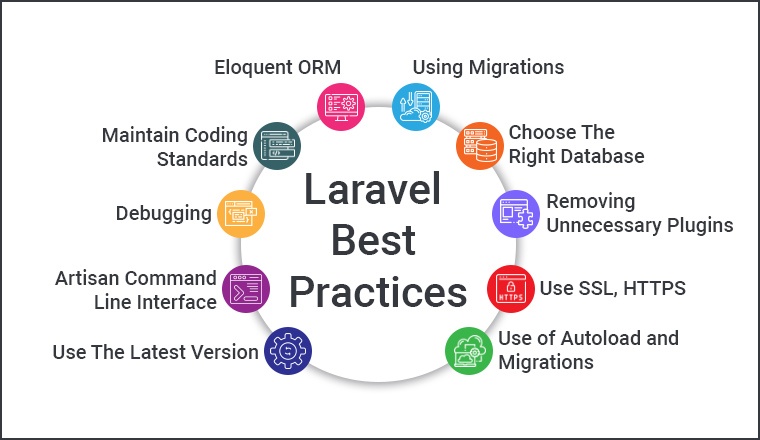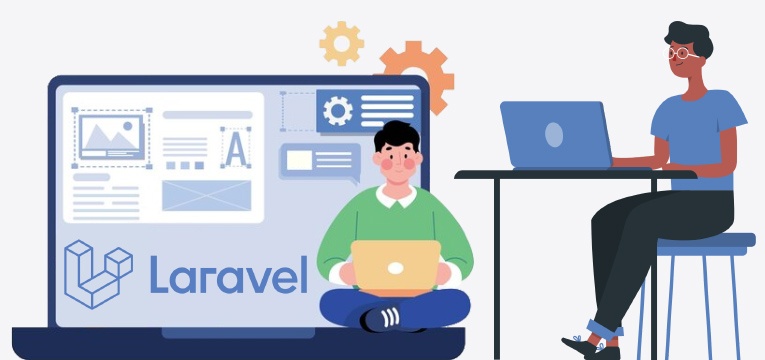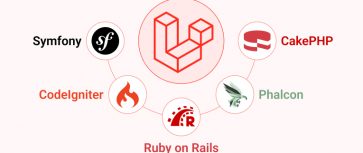Table of Content
Top 10 Laravel Best Practices You Should Follow
When a robust, efficient, and economical platform is all set to offer the simplest way of development for complex enterprise applications. What would you prefer? Well, we are talking about the Laravel framework as a preferable way to develop a web application. Innumerable reasons contribute towards making Laravel one of the chalk horses in the web app development process. Laravel is free as it is an open-source PHP framework and it comes with several easily accessible and cutting-edge features such as easier verification, secure routing, unit tests, and a lot more that are moreover desirable than achievable.
In this blog post, we are going to discuss all the most sought-after Laravel best practices that will help businesses as well as naïve Laravel developers India to understand what to follow. Here is a list of tried and tested tricks that will help everyone who is seeking help with the Laravel application development process. So, let’s get started.
1. Laravel Best Practices

1.1 Ensure Working on the Latest Laravel Version
You as a business get to decide what is lucrative for you. Whether it is to develop an application in the existing framework version and then convert it into the latest version or create your web app in the latest version. Well, it is always recommended to use the latest version in case of any web development process. When you utilize the latest version, you can enable all the features that promise a high-performing and secure way of app development.
It is always best to work on the most recent Laravel version. When developing a web solution with Laravel, the most recent version to use is 9.
1.2 Artisan Command Line Interface
Laravel includes the command line interface Artisan. Artisan exists as the artisan script at the root of your web application and provides a number of useful commands that can help you build your application. If you use the Artisan command line interface, you will experience the best web app development facilities and there are standard Laravel naming conventions followed with public function rules.
The Laravel PHP artisan serves command aids in the execution of web apps on the PHP development server. As a web developer, you can use Laravel artisan to develop and test various public functions such as public function store(), public function index(), helper function etc. within the application. It also accepts two additional options. The host can be useful to change the address and port of an application. In the meantime, you can change the application’s port using the port option.
Remember to use the sail command line to invoke Artisan commands if you’re using Laravel Sail as your local development environment. The “sail” will help you run your Artisan commands in the Docker containers of your web application.
1.3 Debugging
Laravel has its own debugging component. However, using debugging packages such as Laravel Debugbar is a good practice because they provide a wealth of useful information for optimizing your application by including a ServiceProvider to register the debug bar and attach it to the output.
You can also use Laravel Dusk, a browser automation testing tool ideal for browser testing applications and APIs. It uses ChromeDriver by default, but can use any Selenium compatible driver.
1.4 Maintain Coding Standards
When you are creating an application, you are using internal code development standards. The standard Laravel tools are expected to upkeep the business logic and develop readable and maintainable code. Every framework has its own set of internal code development guidelines. The good news is that Laravel does not impose these restrictions as long as your variables are compatible with the composer. However, experts advise adhering to the PSR-2 and PSR-4 coding standards.
When you use PSR -2’s you must follow a single style guide that shows a single code standard. PSR has a single responsibility principle with specifications for autoloading classes that are compatible with different path files. You can use tools like GRUMPHP to improve Laravel coding standards.
1.5 Eloquent ORM
Eloquent ORM (object relational model) is a Laravel feature that provides an elegant ActiveRecord implementation for working with your current database. The best practice for working properly with the Eloquent ORM is to take care of your model’s naming convention.
Each database table has a model in the Eloquent ORM. These models are used to interact with the database and perform various operations. It works on the principle that for a table called users, Laravel expects a model called User. It is critical that you follow this naming convention in order to avoid Eloquent-related issues.
1.6 Using Migrations
Making liberal use of migrations is another important point to consider when developing web applications. One can use database migrations to build a table, add and change fields. Laravel Migrations is an excellent best practice that allows you to control the version of your database. It enables your team to easily modify and share the application’s database schema. Migrations are frequently used in conjunction with Laravel’s schema builder to simplify the creation of your application’s database schema.
Rather than creating databases by hand, always use Laravel Migrations. This will drastically reduce your workload.
1.7 Choose The Right Database
Eloquent supports multiple databases, so you don’t have to stick to just MySQL database. MongoDB should be used for records with highly variable attributes. ElasticSearch is ideal for searching and indexing large amounts of data. Use Neo4J for applications requiring complex model relationships. Choosing the right database is a critical best practice that usually yields significant benefits for your applications.
1.8 Removing Unnecessary Plugins
The advantage of Laravel is the large number of third party libraries that can be included in an application. While this is a good thing, the downside is that the application experiences a high level of drag, causing the overall experience to slow down.
This is why it is critical to go over all of the libraries’ data mentioned in the code. If you believe you could do without a library, remove it from the config/app.php file to make the Laravel app run faster. Composer.json is another important file to examine. If you discover a large number of unnecessary plugins, it is time to uninstall them. Furthermore, the laravel developer can easily disable unused plugins without interfering with the rest of the functions.
1.9 Add a Secure Layer of SSL and HTTPS
When you develop an application, you must ensure that you add a layer of security to your development process. Adding SSL certificates will help developers to secure sensitive information by adding encryption over the internet. This is a secure way to send information to anyone over the internet and they can also securely decrypt the data. These Laravel best practices will help businesses to execute queries to the recipient where the information is in an unreadable format.
HTTPS is another essential aspect to make secure use of a website. Starting to make use of HTTPS instead of HTTP. In this way, you can secure the passwords, critical information, customer financial data and more. HTTPS also secures you from any type of vulnerable attacks or breaches of data.
1.10 Use of Autoload and Migrations
You can use any service class or even just plain PHP code in Laravel as long as it can be autoloaded. By preventing PHP from determining whether the file has already been loaded or not, boosts the performance of the scripts. You don’t have to include the file each time you use it in your code either. If and when it is required, PHP will notify you.
The fantastic feature known as Laravel Migrations offers version control for your database. Your development team can easily share and modify the database schema for the application. To create your web application’s database schema quickly, you can frequently use migrations in conjunction with Laravel’s schema builder. It is always advisable to not create a database manually but to always use Laravel Migrations to lessen the load of migration.
2. Conclusion
In the end, we can say that Laravel best practices can help businesses fine-tune and optimize business applications. In order to conclude that you have the best resources to perform best-in-class services, you need to know how this popular PHP framework will bring a difference. Laravel development tools for business processes are all set to bring change to any business if they know the above-mentioned best practices. Laravel developers can create and maintain business web applications that can ensure speed and reliability for the business by implementing the aforementioned tips.

Hardik Dhanani has a strong technical proficiency and domain expertise which comes by managing multiple development projects of clients from different demographics. Hardik helps clients gain added-advantage over compliance and technological trends. He is one of the core members of the technical analysis team.
Are you aware that PHP frameworks are preferred the most and the reasons are pretty obvious? Some of the most obvious reasons are because it...
 Nov 2, 2022
Nov 2, 2022 



Firstly, thank you very much for putting together all of these Laravel best practices. This is a great resource for people like me who don't want to have to go through so many websites just to find what they're looking for.
Very informative blog! I would like to suggest few more laravel best practices which you can add in your blog to make it more developer friendly. These are as follows: Keep Laravel up to date, Choose appropriate packages, optimize performance by caching static resources and Follow the PSR-2 coding style guide.
Hey, Thanks for putting these Laravel best practices altogether. It looks worth the read. I would personally like to recommend your blog to one of my publications. Thanks a ton!
First of all Thanks mate for putting these all Laravel best practices together so people like me don't need to go through so many websites just to find what I was looking for. There are so many other things that you can add to your blog to make it more appropriate and developer friendly but still looks decent though. Thanks.